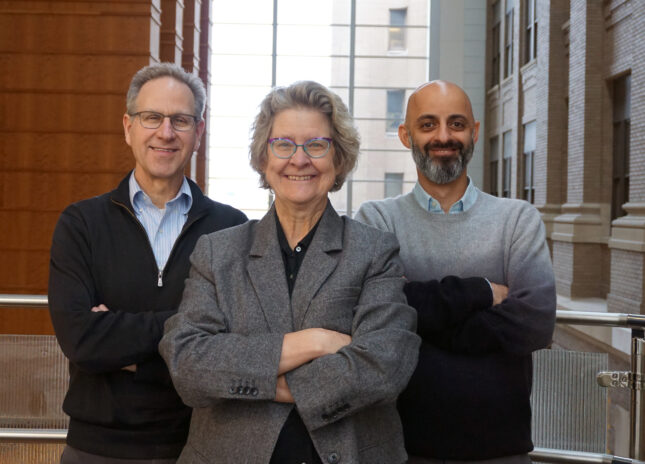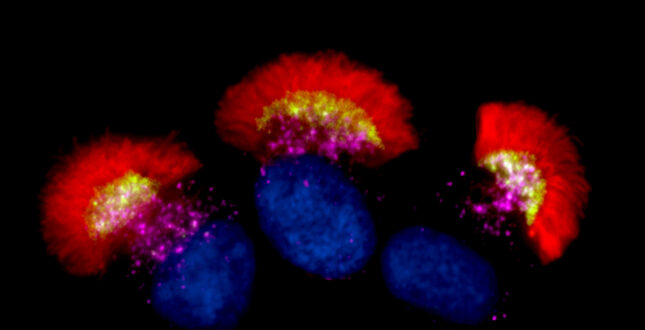
Cilia research collaborators (from left) Steven Brody, MD, Susan Dutcher, PhD, and Moe Mahjoub, PhD, awarded NHLBI Grant to study cilia assembly in lung disease.
Collaborators Moe Mahjoub, PhD, assistant professor of medicine (Division of Nephrology), Cell Biology and Physiology, Susan Dutcher, PhD, professor of genetics, Cell Biology and Physiology, and Steven Brody, MD, the Dorothy R. and Hubert C. Moog Professor of Pulmonary Medicine have received a four-year, $3.14 million RO1 renewal grant from the National Heart, Lung, and Blood Institute (NHLBI) to study the “Regulation of Motile Cilia Assembly in Lung Disease.”
Drs. Mahjoub, Dutcher and Brody are renowned researchers (individually and collectively) of defects in the structure and function of cilia, the hair-like organelles present on most mammalian cells. “These tiny organelles play very important roles in cells. Sensory cilia act like antennas to help relay signals from the extracellular environment, while motile cilia generate the force that can move fluid over the surface of the cell” says Mahjoub. Ciliary defects lead to a range of disease conditions known collectively as ciliopathies, which impact a variety of organs including the lung, kidney, heart and eye, among others. Currently, there are no specific therapies for cilia-related diseases.
“Clearance of pathogens and particulates from the airway is an essential function for host defense and is dependent on the combined actions of airway mucus and beating cilia,” says Brody. “Genetic defects in cilia function result in lung infection and the development of chronic lung disease such as primary ciliary dyskinesis (PCD)”. Although it is known that most PCD mutations result in defective production, transport, or proper placement of ciliary motors along the ciliary axoneme, how this occurs is not understood.

Airway multiciliated cells; cilia shown in red.
The investigators liken the normal process of cilia assembly to navigating from point A to point B in a city. “Just as movement through a city requires multiple modes of transportation, proteins must be moved from the cytoplasm to the basal bodies to the cilium using defined vehicles and routes,” says Dutcher. A continuation of their previous research, which characterized the early steps in the assembly of ciliary motors needed for motility, their current studies will define how these proteins are delivered to their appropriate addresses within each cilium, and how disease-causing mutations impact these key trafficking steps. “Recent cryo-EM data with the Zhang lab (Department of Biochemistry and Molecular Biophysics) has allowed us to identify key amino acids in the proteins that provide “zip codes” for the delivery of specific complexes,” says Dutcher. “This is important both for understanding the biology of the system as well as predicting which amino acid variants may be pathogenic.” They believe that identifying steps that provide critical points of control, and are causes for genetic motile cilia disease, can be adapted as targets for therapy.
Mahjoub, Dutcher and Brody are part of the Washington University Cilia Group. “The Cilia Group has been developed over the past 10 years to share common scientific goals and approaches,” says Mahjoub. “Indeed, the current grant involves collaborations with two other members, Dr Philip Bayly, PhD, chair and Lilyan & E. Lisle Hughes Professor of Mechanical Engineering, and Dr. Rui Zhang, PhD, assistant professor of biochemistry and molecular biophysics. The group currently consists of 10 laboratories (Brody, Dutcher, Mahjoub, Bayly, Horani, Ferkol, Hughes, Zhang, Stratman and Strahle) that contribute clinical, genetic, cell biological, bioengineering and biophysical aspects of the projects. As a result, we have established a rich, multidisciplinary environment.”
The group formally meets every two weeks to present and discuss data. Relationships among laboratory members, particularly trainees, have been fostered to promote cross training in methodologies, and collaborations leading to team science publications. The group has provided for extensive collaboration of the PIs, in various combinations, over the years. The Cilia Group is looking to recruit motivated graduate students, postdoctoral fellows, and research assistants. Interested parties should contact one of the investigators directly, and provide a letter of interest and updated CV.